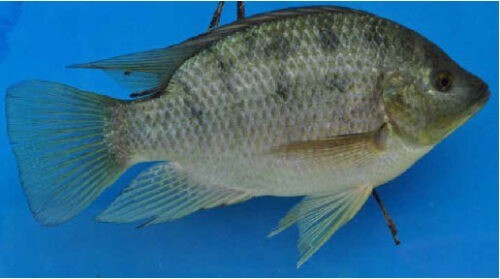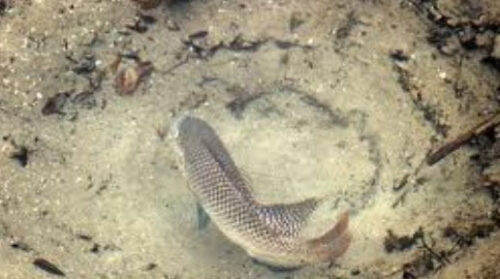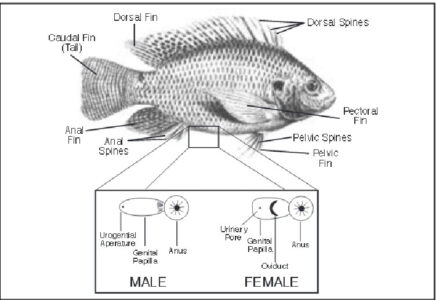Tilapia (Oreochromis mossambicus) belongs to the family Cichlidae under order Perciformes of class Actinopterygii. The English names are Tilapia, Mozambique Cichlid, Mozambique Tilapia, Java Tilapia, Miracle Fish (Indonesia). It is native to inland and coastal waters in southeastern Africa, from the Zambezi basin in Mozambique, Malawi, Zambia and Zimbabwe to Bushman river in the province of South Africa.
Tilapia is a universal fish that is considered to be the most important fish species of the 21st century. It became popular at the farmer level in the early part of the current century. Tilapia can breed very fast. This fish currently occupies an important place in fish farming in many countries. Due to the demand in the local market and its high market price, farmers are currently cultivating this fish at a higher rate.
Its popularity among farmers is also increasing day by day due to its ability to take natural food, interest in supplementary food, survival in adverse natural environment and high immunity. Moreover, the demand in the international market is increasing day by day. Tilapia fish survive at 12-40 0 C and grow at 18-35 0C. It can grow up to 45 cm in length and 1.1 kg in weight with a lifespan of 11 years.
Enter your text here…
Systematic Position
- Phylum: Chordata
- Subphylum: Vertebrata
- Class: Actinopterygii
- Order: Perciformes
- Suborder: Labroidei
- Family: Cichlidae
- Genus: Oreochromis
- Species: Oreochromis mossambicus
Synonyms
Chromis mossambicus Peters 1852; Tilapia mossambica Jones and Sarojini, 1952; Oreochromis mozambica Trewavas,1983; Chromis dumerilii Steindachner, 1864;Tilapia dumerilii (Steindachner, 1864);Chromis vorax Pfeffer, 1893;Chromis natalensis Weber, 1897; Tilapia arnoldi Gilchrist and Thompson, 1917; Oreochromis mossambicus bassamkhalafi Khalaf, 2009
Generic Groups of Tilapia
Fisheries scientists and taxonomists have changed the name of the tilapia at different times based on different characteristics, especially spawnning and reproductive behavior, as the basis of their research. Dr. E. Trewavas is a senior tilapia expert at the British Museum of Natural History. In his book, Tilapiine Species, he gives a description of the natural history of the African Cichlid species and distinguishes the African Cichlid as Tilapia, Sarotherodon and Oreochromis. According to Dr. E. Trewavas, the three main groups of tilapia are:
Genus: Tilapia- The species belonging to this genus breeds on submerged material and they do not take their eggs in their mouths for hatching. E.g. Tilapia zillii
Genus: Sarotherodon– Male fish of this genus mainly keep eggs in their mouths for hatching and care for both (male and female) newly hatched larvae. E.g. Sarotherodon galilaeus, Sarotherodon melanotheron
Genus: Oreochromis– Female fishes of this genus keep their eggs in their mouths for hatching. Male fish build nests and protect their breeding areas from being attacked by other males. The female fishes play the role of breeding mates. For example: Oreochromis niloticus, Oreochromis mossambicus, Oreochromis aureus etc.
Well cultivated Species of Tilapia
| Genus | Species |
| Tilapia | Tilapia zillii Tilapia rendalli |
| Sarotherodon | Sarotherodon galilaeus Sarotherodon melanotheron |
| Oreochromis | Oreochromis niloticus Oreochromis mossambicus Oreochromis aureus Otreochromis hornorum Oreochromis macrochir Oreochromis andersoni |
Habitat and Habitat
The Tilapia are native to the rivers that stretch along the east coast of Africa, from the Gulf of Algoa in South Africa to the Shebali River in western Somaliland. Tilapia has migrated to countries including Bangladesh, Java, Malaysia, Philippines, Pakistan, India, Tanzania, Uganda etc. It can be cultivated in freshwater and brackish water ponds.
Tilapia is omnivorous. At the young stage, they eat only diatoms and other plankton species. Later, immature and adult tilapia became accustomed to all kinds of food. In case of pond cultivation, they eat rice and wheat husk, flour, masturd oil cake etc. In four to six months, they weigh 200-350 grams. No special techniques are required for breeding and laying eggs. They become fertile in 3-4 months. They usually breed every 2-3 months throughout the year.
During breeding, male fish make round holes at the edge or bottom of the pond and female fish lay their eggs here. In some species of tilapia, females insert fertilized eggs and young into their mouths in the event of an enemy attack. That is why they are called as mouthbreeders. Although they live in freshwater, they can also live in estuarine areas. In many countries, especially in Bangladesh they are found in canals, beels, haors, baors and ponds.
A mature male tilapia grows to 30-44 cm in length and a mature female grows to about 25-33 cm. On the other hand, a male tilapia becomes sexual maturity at 10-30 cm in length. Mozambique Tilapia has been studied in many countries around the world. The following table shows the maximum total length of Mozambique Tilapia obtained from the results of various studies:
|
Place and Country |
Total length(cm) |
Source/Researchers |
|---|---|---|
|
Ross River weirs (1997/98), Townsville, Qld, Australia |
43.8 |
Webb, unpubl |
|
Inyamiti pan, KwaZulu, South Africa |
43.2 |
Bruton & Allanson,1974 |
|
Ross River weirs (1992) Townsville, Qld, Australia |
41.3 |
Webb, unpubl. data |
|
North Pine Dam, Brisbane, Qld, Australia |
41.2 |
Blühdorn et al. 1990 |
|
Egyptian culture ponds |
38.0 |
Bruton & Allanson,1974 |
|
Curralea Lake (1990), Townsville, Qld, Australia |
36.4 |
Milward & Webb,1990 |
|
Reservoir, Trinidad |
35.6 |
Hickling 1961 |
|
Kiribbanara Reservoir, Sri Lanka 35.5 De |
35.5 |
De Silva 1985 |
|
Ross Dam, Townsville-Thuringowa, Qld, Australia |
34.5 |
Webb 2006 |
|
Pimburettewa Reservoir, Sri Lanka |
33.0 |
De Silva 1985 |
|
Tingalpa Dam, Brisbane, Qld, Australia |
32.6 |
Blühdorn et al.1990 |
|
Mahagama Reservoir, Sri Lanka |
32.0 |
De Silva 1985 |
|
Cairns, Qld, Australia |
31.9 |
Blühdorn et al. 1990 |
|
Kaudulla Reservoir, Sri Lanka |
28.0 |
De Silva 1985 |
|
Guthries Pond, Cairns, Qld, Australia |
26.2 |
Blühdorn et al. 1990 |
|
Lake Sibaya, KwaZulu, South Africa |
26.0 |
Bruton & Allanson,1974 |
|
Yodawewa Reservoir, Sri Lanka |
25.0 |
De Silva 1985 |
|
York Dam, Jamaica |
22.0 |
Hickling 1961 |
|
Gascoyne River, WA, Australia |
15.4 |
Blühdorn et al. 1999 |
|
Buffalo Springs, Kenya |
10.0 |
Whitehead 1962 |
Physical Description
The body is long, well pressed and rounded. Their jaws are protruding, their lips are thick and their mouths are wide. The teeth are small in shape and arranged in jaws in 3-5 rows. They have a long dorsal fin; in females and immature males the longest dorsal soft ray extends to the anterior edge of the tail fin but in mature males it extends to more than half of the tail fin.
The body is covered by cycloid scales and there are 30-32 scales along the lateral line. The scales on the snout and head are large in size and the scales on the body are small in size. Mature males have long jaws with 3 rows of scales. In females and males, the body is gray or yellowish in color and has 3-4 black spots along the sides of the body.

Mozambique Tilapia (Oreochromis mossambicus)
During the breeding season, these spots turn dark black. The underside of the head is whitish gray and the upper lip is bluish. The dorsal fins are black and the edges are reddish. The dorsal fin has 15-18 spines and 10-12 soft rays. The thoracic fins are light red with 14-15 soft rays and the pelvic fins have 1 soine with 5 rays. There are 3 spines and 10-11 soft rays in the anal fins. The tail fins have wide red edges. They can grow up to 45 cm in length and live up to 11 years.
Reproduction
Tilapia can breed in suitable environment almost all the year round. Their reproduction is affected by temperature. They usually breed at 18-25 degrees Celsius. During the breeding season, they build round nests on the edge or bottom of ponds in areas rich in aquatic plants, and the female fish lay their eggs here. The size of these nests depends on the size of the male fish and the depth of the water. The diameter of the house is usually 30-164 cm (average diameter 64 cm).

Male Tilapia during making nest
Female fishes store eggs in the center of these nests. The female fish keeps the fertilized eggs in her mouth for about 22 days and nurtures them in her mouth for 14 days to protect them from any enemy. A female fish can lay 100 to 2300 eggs at a time. The number of eggs depends on the size of the fish. Eggs are usually pear-shaped and bright yellow to yellowish brown in color. Each egg is 1.9-3.0 mm in diameter. The eggs hatch between 3-5 days and the fry fish are reared under the supervision of fish for about 7 days. At night the fry move in deep water and during the day they form large flocks.

Fins and genital papillae of male and female tilapia (Oreochromis)
Table: Breeding coloration of different species of males Tilapia
|
Species |
Head Region |
Trunk |
Fins |
|---|---|---|---|
| Oreochromis niloticus |
Lips are normal; The skull is light pink; Neck white; |
Light pink; The abdomen is dark in color; |
The edges of the dorsal fin are bluish-black; |
|
Oreochromis aureus |
Lips are normal; Lower lip whitish; The head is gray-blue and the neck is white; |
The sides of the body are gray-blue; Abdomen white; |
The upper edges of the dorsal fin are orange; Tail fins colorless; Anal fins light yellowish or whitish; |
|
Oreochromis mossambicus |
Lips protruding; The head is black; The lower cheek is black and the neck is white; |
Body black; |
All types of fins are black but the edges are orange-red; |
|
Oreochromis hornorum |
Lips protruding; The head is black; |
Body black; |
All types of fins are black |
|
Oreochromis spilurus |
Lips protruding; The head is light pink; |
The lateral regions of the body are gray; The edges of the scales are yellow; Abdomen is light yellow in color; |
Dorsal fins with dark blue edges; Tail fin feathered checkered; |
|
Oreochromis macrochir |
Lips are normal; Head is gray-blue; |
Abdomen and lateral edges of body are dark blue; The genital papilla is transformed into a tassel; |
All types of fins are dark blue, especially the dorsal fins are bright blue; |
|
Sarotherodon galilaeus |
Lips are normal; Head is yellowish-golden; The scales above the head are brightly colored; |
The abdomen and lateral edges of the body are golden gray in color and occasionally black spots exist; |
Pelvic and anal fins black; |
|
Tilapia zillii |
Lips are normal; Head is gray-black; The lower chin and neck are orange-red; |
The lateral edges of the body are gray-black; the abdomen is orange-red; The genital papilla is long and pointed; |
All types of fins are dark gray; |
Economic Importance
They can survive at freshwater (<0.5 ppt) and salt water (34-38 ppt) environments, making it possible to cultivate this fish in coastal areas. Its popularity among farmers is increasing day by day due to its ability to take natural food, interest in supplementary food, survival in adverse natural environment and high immunity. Moreover, the demand in the international market is increasing day by day. Tilapia fish survive at 12-40 0 C and grow at 18-35 0 C.
In the tropical countries, tilapia can be cultivated at least twice in the same pond. Such fish also play an important role in controlling aquatic weeds and mosquito larvae. Such fish is also a trouble tolerant fish. Its importance as food is increasing day by day all over the world. It is also acceptable as an aquarium fish.
